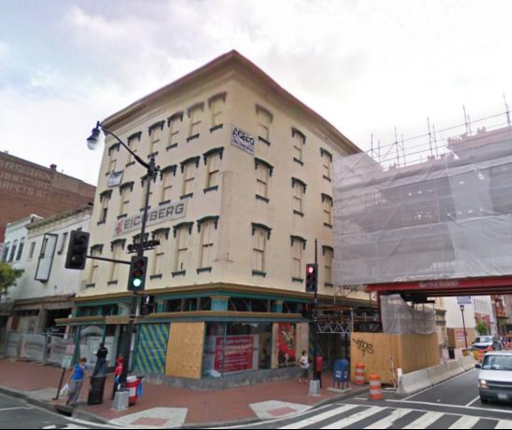By
According to Roy, the foundry had been constructed as a “rectangular donut with enormous courtyard in the middle for ships.” With SK&I Architectural Design Group creating 170 residences—33 of them newly-constructed two-level penthouses on the 5th and 6th floors, all are designed to discharge on one side into a windowed corridor that directs residents’ attention to the 4,400 s.f. social courtyard below.
Beth Herman
En route from France on the USS Olympia, the body of World War I’s Unknown Soldier passed through the history-imbued Washington Navy Yard on its way to the Capitol Rotunda, and ultimately Arlington National Cemetery. Created to build and maintain ships more than 200 years ago, and becoming the world’s largest naval ordnance plant by World War II, the Navy Yard—and especially its 221,500 s.f. foundry building — were home to the design and construction of weapons used in every war from 1883 until the 1960s, when the Yard became the ceremonial and administrative hub for the U.S. Navy.
"We focused on that history—so much history,” said Sabine Roy, owner and principal of SR/A Interior Design LLC, when the firm was commissioned by developer Forest City Washington, with SK&I Architectural Design Group, to turn the brunt of the landmark building into a singular residential property: Foundry Lofts, 301 Tingey Street SE. “We based our design on research with the naval archives, the Library of Congress, historical photographs, antique documentation–whatever we could do,” she affirmed.
Informed by 200 years of military lore, Roy said the structure’s context allowed the firm to be more “modern and urban” in its interior design concept, noting a combination of new construction (which this facility was not) and modern may result in an environment that is too cold. “But with an historic building, you already  have this warm, worn look,” she explained, adding it’s been “humanized.”
have this warm, worn look,” she explained, adding it’s been “humanized.”
 have this warm, worn look,” she explained, adding it’s been “humanized.”
have this warm, worn look,” she explained, adding it’s been “humanized.”
That said, attracting active professionals to its 170 units and amenities was a programmatic priority, high on the list of design determinants. Boasting elements such as a sunken conversation area in the concrete lobby and a courtyard—where war ships were once fashioned—reincarnated into a sleek social club, the addition of an outdoor fireplace, cinema, and rooftop garden terrace with seating and art make Foundry Lofts a rare residential  experience.
experience.
 experience.
experience.
Anchors away
Fraught with pendulous columns that supported an industrial floor plan, the building was also higher than the street and not meant to be entered from the sidewalk, but rather the water, so ships could be launched, Roy explained. Consequently the concrete lobby floor had to be elevated a few feet to street level, though a designated seating area, replete with new fireplace and modern art, was left below grade for a sunken effect.

According to Roy, the foundry had been constructed as a “rectangular donut with enormous courtyard in the middle for ships.” With SK&I Architectural Design Group creating 170 residences—33 of them newly-constructed two-level penthouses on the 5th and 6th floors, all are designed to discharge on one side into a windowed corridor that directs residents’ attention to the 4,400 s.f. social courtyard below.

An indoor courtyard-adjacent space, designated as a party room, was extended further into the courtyard, with a modern outdoor fireplace—glowing winter and summer— visible from inside as well. Atop the party room, a rooftop terrace with metal sculptures and Asian-style grasses create a Zen garden effect, according to Roy, with soft, strategic lighting limited to showcasing the art. From a large stair, residents can descend into the courtyard to play bocce or relax in hammocks, or on colossal square ottomans that seat up to five, and which are lit from the center. Old movie nights at the courtyard’s outdoor cinema will be a lot of fun, Roy suggested, envisioning classic black-and-white movies and martini parties for residents and their guests.


Columns, canons and carpeting
“When we entered the building,” Roy said of the team’s initial foray in early 2010, there was nothing new though it had been cleaned up. You just saw the structural columns and old heating systems and exterior walls.” All in all, she said, it was “an emotional experience when you think about the consequences of what was built here—what it did to the rest of the nation.”
In an effort to retain much of the historical fabric, a legion of pendulous structural columns was left alone including one “smack in the middle of the lobby,” Roy said. A challenge due to their size and girth, the designer said the lobby column, specifically, became a focal point, with a dressing added to accommodate adornments such as flowers. A Civil War-era canon unearthed during renovation that had later seen action aboard the USS Raritan was installed in the lobby, and will help distract from the behemoth column. The juxtaposition of the historical lobby with contemporary fabrics, furniture and modern art in the space is a further manifestation of Foundry Lofts’ aesthetic.

With dislodged historical components like the repurposed canon integral to the building’s design and sustainability, the latter is achieved on many levels. Roy said all elements—carpeting; furniture; paint; backings—are recycled content or post-consumer recycled material. The party room is bamboo, and courtyard flooring is earth-friendly Trex.
According to Forest City Washington’s Senior Vice President of Development Ramsey Meiser, Foundry Lofts’ mixed-use component includes three retail spaces, two of which have been leased to Pot Belly’s and Kruba Thai and Sushi, which will be open in the first quarter of 2012.
“This building is so unique in its adaptive reuse of an existing building,” Meiser said, noting he is buoyed by marketplace reaction and the results of preleasing efforts for residences which will be available at the end of October or beginning of November of the current year.






























